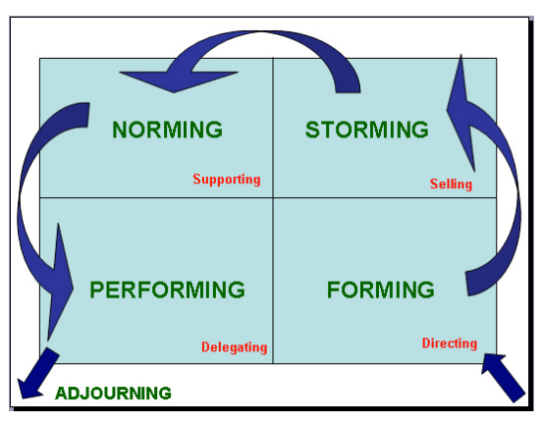Problem Statement
Leading a team could be difficult, especially if you don’t know position of your team. AACE team was established in late August 2013, through 5 days intensive course. This team consists of multi-background persons who will collaborate in tasks, in two purposes: passing AACE exam and getting return of training investment. The leader needs to know the best way to lead the team to pass those purposes.
Feasible Alternative: Tuckman Model Based-Leadership
Tuckman model, developed by Bruce Tuckman in 1965, explains that there are 4 stages of team behavior: Forming, Storming, Norming and Performing. In 1975 he added a fifth stage, which is Adjourning.
Forming, the members of the team get to know one another.
- High learning, no trust yet, unfamiliar with group members, people are not committed to the team
Storming, the team addresses issues such as what problems they are really supposed to solve.
- Roles and responsibilities are articulated, problem solving doesn’t works, people want to modify the team mission / trying new idea, little team spirit.
Norming, stage goals are set and plans are made.
- Appreciation and trust build, purpose is well defined, team confidence is high, team gains commitment from all members on direction and goals.
Performing, teams are able to function as a unit as they find ways to get the job done smoothly and effectively.
- Team members feel motivated, team members have objective outlook, high empathy, high trust in everyone.
Adjourning, is the break-up of the group, when the task is completed successfully.
- Members moving out of the group after project goal achievement, everyone can move on to new things, achievement celebrated
After Tuckman declare his model, Hersey and Blanchard introduced Situational Leadership that can be integrated with Forming-Storming-Norming-Performing model.
Figure 1. Integrated Tuckman’s Model with Hersey and Blanchard’s model
Outcome of Tuckman Model for the Problem
For knowing the position of AACE team in Forming-Storming-Norming-Performing model, each member should fill the questionnaire in link below:
http://www.cscaweb.org/EMS/sector_team/support_files/tools_for_the_team/tool_stage.pdf
Questionnaire result from 11 team members, are shown below:
| Performing Stage | Norming Stage | Storming Stage | Forming Stage | |
| HPO | 25 | 24 | 26 | 31 |
| ASY | 39 | 30 | 22 | 27 |
| SSG | 27 | 26 | 25 | 22 |
| TOM | 34 | 30 | 22 | 29 |
| APE | 20 | 22 | 20 | 20 |
| WAS | 38 | 32 | 25 | 29 |
| ANG | 28 | 28 | 23 | 22 |
| AFS | 29 | 28 | 23 | 22 |
| HWB | 24 | 24 | 21 | 27 |
| SSD | 31 | 26 | 19 | 25 |
| AEP | 22 | 22 | 20 | 24 |
Table 1. Raw Data
| Min | AVR / mean | Max | Range | Sigma | Variance | P80 Z = 0.84 | TUCKMAN’s MODEL |
| 20 | 25 | 31 | 11 | 2 | 3 | 27 | Forming Stage |
| 19 | 22 | 26 | 7 | 1 | 1 | 23 | Storming Stage |
| 22 | 27 | 32 | 10 | 2 | 3 | 28 | Norming Stage |
| 20 | 29 | 39 | 19 | 3 | 10 | 32 | Performing Stage |
Table 2. Questionnaire Analyzing result
Using excel : NORM.S.INV(0.8); Z = 0.84
Result: Delegating Leadership Style
From data above, AACE team is now on Performing Stage, because that stage has the highest score (average score is 29), and in P80 it scores 32.
We can also see that average score for Norming stage is 27, close with Performing score. That indicates AACE team was transitioning from Norming to Performing stage.
Based on Hersey and Blanchard’s model, leadership styles which suits this team best in Performing Stage is Delegating. Leader can delegate all work he sensibly can, and focus on developing team members.
Performing stage score also has big variance, so there’s a big difference in data input. Five days Intensive Class makes team members getting closer, so they can get to know each other and share the same objectives. Leader should keep the team motivated so they can stay in Performing Stage to finish their task.
Source:
Babou Srinivasan (2008). Forming Storming Norming Performing Developmental Model. [ONLINE] Available at: http://leadershipchamps.wordpress.com/2008/04/28/forming-storming-norming-performing-developmental-model/. [Last Accessed 1 September 2013].
Carol Wilson (2010). Bruce Tuckman’s Forming, Storming, Norming & Performing Team Development Model. [ONLINE] Available at: http://www.performancecoachtraining.com/resources/docs/pdfs2/BruceTuckman_Team_Development_Model.pdf. [Last Accessed 1 September 2013].
Jose Almeida (2012). Tuckman’s Model of Team Development and Dynamics. [ONLINE] Available at: http://thousandinsights.wordpress.com/articles/on-leadership/tuckmans-model-of-team-development-and-dynamics/.%5BLast Accessed 1 September 2013].
http://www.businessballs.com/tuckmanformingstormingnormingperforming.htm


Pagi from Shanghai, Pak Wirawan, You did a good job on your analysis (not sure if I agree with the outcomes but you did a good job analyzing the data) BUT, while you did Step 1 and Step 2 just fine, where are steps 3, 4, 5 6 and 7?
VERY important that you get in the habit of following the 7 Step template I provided to you…..
I will accept this posting (3 stars) but in the coming weeks, if you don’t follow the step by step process shown on page 7 of your engineering economy, I will start to reject your postings.
Why is this so important? Because it is the best way to ensure that you pass the very challenging ESSAY question on your AACE exams and it will also help you with your CCC/CCE PAPER……
BR, Dr. PDG, Shanghai, China